#Power System Analysis Software
Explore tagged Tumblr posts
Text
Global Power System Analysis Software Market Is Estimated To Witness High Growth Owing To Increasing Demand For Enhanced Grid Stability

The global Power System Analysis Software market is estimated to be valued at US$ 6922.7 Mn in 2021 and is expected to exhibit a CAGR of 13.4% over the forecast period 2022-2030, as highlighted in a new report published by Coherent Market Insights. A) Market Overview: Power System Analysis Software is widely used in the energy sector to analyze and optimize the performance of power systems. It helps in assessing the stability, reliability, and safety of the power grid by simulating various operating conditions. The software provides valuable insights into system behavior, identifying potential issues, and suggesting suitable solutions. With the increasing complexity of power systems and the growing need for grid stability, the demand for power system analysis software is expected to surge in the coming years. B) Market Key Trends: One key trend driving the growth of the Power System Analysis Software market is the increasing adoption of renewable energy sources. As countries strive to reduce their carbon footprint and transition towards cleaner energy sources, there has been a significant rise in the integration of renewable energy into the power grid. Power system analysis software plays a crucial role in ensuring the smooth integration of renewable energy sources by analyzing their impact on the grid and optimizing their usage. For example, the software can predict fluctuations in solar or wind power generation and adjust grid parameters accordingly to maintain stability. C) PEST Analysis: - Political: Governments worldwide are focused on implementing policies and regulations that promote clean energy and grid stability. This creates a favorable environment for the growth of the Power System Analysis Software market. - Economic: The rising demand for electricity, coupled with the increasing penetration of renewable energy sources, is driving investments in advanced power system analysis software. - Social: Growing awareness about environmental conservation and the need for sustainable energy solutions is influencing consumer preferences and encouraging the adoption of power system analysis software. - Technological: Technological advancements in software capabilities, such as real-time monitoring, predictive analytics, and machine learning, are enhancing the performance and functionality of power system analysis software. D) Key Takeaways: The global Power System Analysis Software Market Size is expected to witness high growth, exhibiting a CAGR of 13.4% over the forecast period, due to the increasing adoption of renewable energy sources. The software helps in optimizing grid stability and addressing challenges associated with integrating renewable energy into the power grid.
In terms of regional analysis, North America is expected to dominate the Power System Analysis Software market, owing to the presence of key market players and the growing focus on renewable energy projects in the region. Asia Pacific is anticipated to be the fastest-growing region, driven by rapid industrialization and increasing investments in power infrastructure.
Key players operating in the global Power System Analysis Software market are ABB Ltd., Electricity Coordinating Center Ltd., Siemens AG, Energy Exemplar, Atos SE, General Electric Company, Unicorn Systems, ETAP/Operation Technology, Inc., Operation Simulation Associates, Inc., Schneider Electric DMS NS, PSI AG, and Artelys SA. These players are actively involved in developing innovative software solutions and collaborating with utilities to enhance grid stability. The global Power System Analysis Software market is poised for significant growth in the coming years. The increasing demand for enhanced grid stability, driven by the integration of renewable energy sources, is expected to fuel the adoption of power system analysis software. With technological advancements and supportive government policies, the market presents lucrative opportunities for both established players and new entrants.
#Power System Analysis Software#Power System Analysis Software Market#Power System Analysis Software Market Size#Power System Analysis Software Market Growth#Power System Analysis Software Market Trends#Information and Communication Technology
0 notes
Text
Electric Power System Analysis Software, Global Top 10 Players, Market Share and Ranking (2023)
Electric Power System Analysis Software Market Summary
Electric Power System Analysis Software include electric power generation, distribution, transmission, trading and sales, protection etc.

According to the new market research report “Global Electric Power System Analysis Software Market Report 2024-2030”, published by QYResearch, the global Electric Power System Analysis Software market size is projected to reach USD 2.86 billion by 2030, at a CAGR of 6.2% during the forecast period.
Figure. Global Electric Power System Analysis Software Market Size (US$ Million), 2019-2030

Figure. Global Electric Power System Analysis Software Top 10 Players Ranking and Market Share (Ranking is based on the revenue of 2023, continually updated)

According to QYResearch Top Players Research Center, the global key manufacturers of Electric Power System Analysis Software include Siemens, ABB, Eaton Corporation, Schneider Electric, General Electric, Resource Innovations (Nexant), Atos SE, OATI, ETAP (Operation Technology), Open Systems International (OSI), etc.
In 2023, the global top 10 players had a share approximately 45.0% in terms of revenue.
Figure. Electric Power System Analysis Software, Global Market Size, Split by Product Segment
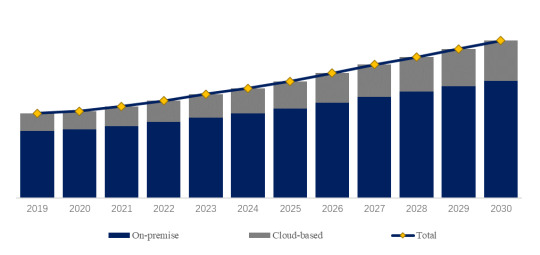
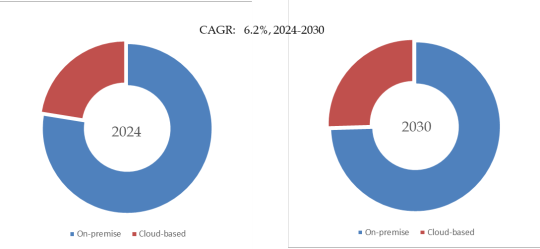
In terms of product type, currently On-premise is the largest segment, hold a share of 77.6%.
Figure. Electric Power System Analysis Software, Global Market Size, Split by Application Segment
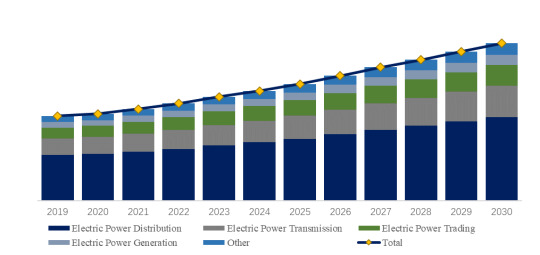

In terms of product application, currently Electric Power Distribution is the largest segment, hold a share of 53.3%.
Figure. Electric Power System Analysis Software, Global Market Size, Split by Region
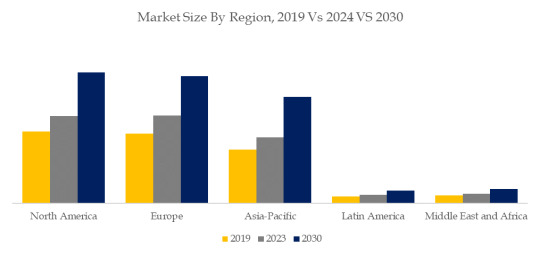
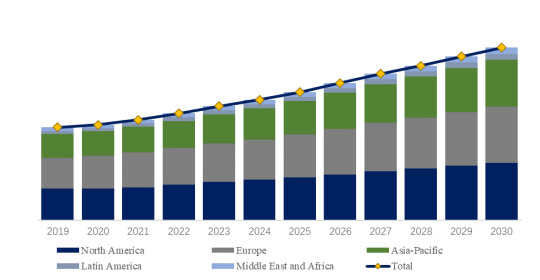
About QYResearch
QYResearch founded in California, USA in 2007.It is a leading global market research and consulting company. With over 17 years’ experience and professional research team in various cities over the world QY Research focuses on management consulting, database and seminar services, IPO consulting, industry chain research and customized research to help our clients in providing non-linear revenue model and make them successful. We are globally recognized for our expansive portfolio of services, good corporate citizenship, and our strong commitment to sustainability. Up to now, we have cooperated with more than 60,000 clients across five continents. Let’s work closely with you and build a bold and better future.
QYResearch is a world-renowned large-scale consulting company. The industry covers various high-tech industry chain market segments, spanning the semiconductor industry chain (semiconductor equipment and parts, semiconductor materials, ICs, Foundry, packaging and testing, discrete devices, sensors, optoelectronic devices), photovoltaic industry chain (equipment, cells, modules, auxiliary material brackets, inverters, power station terminals), new energy automobile industry chain (batteries and materials, auto parts, batteries, motors, electronic control, automotive semiconductors, etc.), communication industry chain (communication system equipment, terminal equipment, electronic components, RF front-end, optical modules, 4G/5G/6G, broadband, IoT, digital economy, AI), advanced materials industry Chain (metal materials, polymer materials, ceramic materials, nano materials, etc.), machinery manufacturing industry chain (CNC machine tools, construction machinery, electrical machinery, 3C automation, industrial robots, lasers, industrial control, drones), food, beverages and pharmaceuticals, medical equipment, agriculture, etc.
0 notes
Text
Exploring the Benefits of AI SEO Tools for Your Website
AI SEO tools are transforming the way we approach search engine optimization. In today’s fast-paced digital world, leveraging AI SEO tools can give your website a significant edge over the competition. These advanced tools use artificial intelligence to enhance various aspects of SEO, making it easier for your content to rank higher on search engine results pages (SERPs). Let’s dive into how AI…
#advanced SEO tools#AI and data analysis#AI content optimization#AI ethical concerns#AI for keyword research#AI in digital marketing#AI in everyday life#AI in search engine optimization#AI limitations#AI natural language processing#AI SEO benefits#AI SEO optimization#AI SEO strategies#AI SEO tools#AI SEO trends 2024#AI-based SEO solutions#AI-driven SEO analysis#AI-powered SEO#artificial intelligence SEO#autonomous AI systems#best AI SEO software#creative AI applications#future of AI#machine learning SEO tools#SEO automation with AI#SEO tools with AI#top AI SEO platforms#what AI can do
0 notes
Text

Business Intelligence Analytics - Enterlogix Corporation
Enterlogix Corporation offers advanced Business Intelligence Analytics solutions designed to empower businesses with data-driven insights and strategic decision-making capabilities and we help clients unlock the full potential of their data, driving and operational excellence. For more information, visit our website or contact us.
+1 832-278-1229
#salesforce consulting services#Salesforce Consulting Services#Software Auditing Services#Salesforce barcode scanner#Gps barcode scanner#Barcode Reader App#Barcode Scanners Apps#Power Platform Microsoft#Ms Power Apps#Microsoft CRM System#Risk Management Strategy#Risk Analysis Service#Data Rescue Service#Project Rescue Services#Business Intelligence Analytics#Business Intelligence Services#Cloud Strategy Consulting
0 notes
Text
Since I just saw a pretty cool post with Connor's idle animation, it's time to talk about the nature of these little calibrations he does all the time, because they fascinate me.
I know there's this idea in the fandom that all androids need to recalibrate from time to time, and that they especially need to do this after stress or exertion. If you have ever read any fic with an android from this game that involves sex, you know what kind of stress it usually is.
Personally, I'm not a fan of "humanizing" the machines. I think androids are fun because they are inhuman and their objective reality is completely different from ours. The fact that they are constantly aware of every single process in their bodies is fascinating, isn't it? Since they can understand humans and speak fluently, they have to run several language modules all the time. Plus security modules to prevent hacking. Plus visual recognition, plus all the specialized software for their primary functions.
What I mean is that even your standard domestic android like Kara is an immensely complex machine, running thousands of processes simultaneously just to fold Todd's laundry or talk to him about dinner. Why would she need to recalibrate? To take some of the load off her systems? To do a basic check-in of her body? All my parts are still connected and functioning normally? Something like that?
Meanwhile, Connor is much, much more complex than someone like Kara or even Marcus. All those analysis modules he runs all the time, all those database connections he constantly maintains. On top of that, he has to be faster and more agile than any existing android, and he has to do combat, reconstruction, and pre-construction. His "brain" has to be so fucking fast.
And that's what fascinates me. I think Connor's consciousness and how fast he thinks actually affects how he's connected to his body. His coin, all of his complex recalibration movements are necessary because all of his immense processing power is contained in such a small body. He literally has to slow himself down to just move properly. How cool is that?
I have this idea that Connor is actually much bigger than his body, and his consciousness is only partially uploaded to each of his chassises, and the only time we see him "whole" is during his conversations with Amanda. This may explain why he can upload himself on other bodies and why his calibrations are so elaborate. He needs to do more to connect with his physical body. (I actually drafted a whole fic that explores this idea)
172 notes
·
View notes
Text
The Story of KLogs: What happens when an Mechanical Engineer codes
Since i no longer work at Wearhouse Automation Startup (WAS for short) and havnt for many years i feel as though i should recount the tale of the most bonkers program i ever wrote, but we need to establish some background
WAS has its HQ very far away from the big customer site and i worked as a Field Service Engineer (FSE) on site. so i learned early on that if a problem needed to be solved fast, WE had to do it. we never got many updates on what was coming down the pipeline for us or what issues were being worked on. this made us very independent
As such, we got good at reading the robot logs ourselves. it took too much time to send the logs off to HQ for analysis and get back what the problem was. we can read. now GETTING the logs is another thing.
the early robots we cut our teeth on used 2.4 gHz wifi to communicate with FSE's so dumping the logs was as simple as pushing a button in a little application and it would spit out a txt file
later on our robots were upgraded to use a 2.4 mHz xbee radio to communicate with us. which was FUCKING SLOW. and log dumping became a much more tedious process. you had to connect, go to logging mode, and then the robot would vomit all the logs in the past 2 min OR the entirety of its memory bank (only 2 options) into a terminal window. you would then save the terminal window and open it in a text editor to read them. it could take up to 5 min to dump the entire log file and if you didnt dump fast enough, the ACK messages from the control server would fill up the logs and erase the error as the memory overwrote itself.
this missing logs problem was a Big Deal for software who now weren't getting every log from every error so a NEW method of saving logs was devised: the robot would just vomit the log data in real time over a DIFFERENT radio and we would save it to a KQL server. Thanks Daddy Microsoft.
now whats KQL you may be asking. why, its Microsofts very own SQL clone! its Kusto Query Language. never mind that the system uses a SQL database for daily operations. lets use this proprietary Microsoft thing because they are paying us
so yay, problem solved. we now never miss the logs. so how do we read them if they are split up line by line in a database? why with a query of course!
select * from tbLogs where RobotUID = [64CharLongString] and timestamp > [UnixTimeCode]
if this makes no sense to you, CONGRATULATIONS! you found the problem with this setup. Most FSE's were BAD at SQL which meant they didnt read logs anymore. If you do understand what the query is, CONGRATULATIONS! you see why this is Very Stupid.
You could not search by robot name. each robot had some arbitrarily assigned 64 character long string as an identifier and the timestamps were not set to local time. so you had run a lookup query to find the right name and do some time zone math to figure out what part of the logs to read. oh yeah and you had to download KQL to view them. so now we had both SQL and KQL on our computers
NOBODY in the field like this.
But Daddy Microsoft comes to the rescue
see we didnt JUST get KQL with part of that deal. we got the entire Microsoft cloud suite. and some people (like me) had been automating emails and stuff with Power Automate

This is Microsoft Power Automate. its Microsoft's version of Scratch but it has hooks into everything Microsoft. SharePoint, Teams, Outlook, Excel, it can integrate with all of it. i had been using it to send an email once a day with a list of all the robots in maintenance.
this gave me an idea
and i checked
and Power Automate had hooks for KQL
KLogs is actually short for Kusto Logs
I did not know how to program in Power Automate but damn it anything is better then writing KQL queries. so i got to work. and about 2 months later i had a BEHEMOTH of a Power Automate program. it lagged the webpage and many times when i tried to edit something my changes wouldn't take and i would have to click in very specific ways to ensure none of my variables were getting nuked. i dont think this was the intended purpose of Power Automate but this is what it did
the KLogger would watch a list of Teams chats and when someone typed "klogs" or pasted a copy of an ERROR mesage, it would spring into action.
it extracted the robot name from the message and timestamp from teams
it would lookup the name in the database to find the 64 long string UID and the location that robot was assigned too
it would reply to the message in teams saying it found a robot name and was getting logs
it would run a KQL query for the database and get the control system logs then export then into a CSV
it would save the CSV with the a .xls extension into a folder in ShairPoint (it would make a new folder for each day and location if it didnt have one already)
it would send ANOTHER message in teams with a LINK to the file in SharePoint
it would then enter a loop and scour the robot logs looking for the keyword ESTOP to find the error. (it did this because Kusto was SLOWER then the xbee radio and had up to a 10 min delay on syncing)
if it found the error, it would adjust its start and end timestamps to capture it and export the robot logs book-ended from the event by ~ 1 min. if it didnt, it would use the timestamp from when it was triggered +/- 5 min
it saved THOSE logs to SharePoint the same way as before
it would send ANOTHER message in teams with a link to the files
it would then check if the error was 1 of 3 very specific type of error with the camera. if it was it extracted the base64 jpg image saved in KQL as a byte array, do the math to convert it, and save that as a jpg in SharePoint (and link it of course)
and then it would terminate. and if it encountered an error anywhere in all of this, i had logic where it would spit back an error message in Teams as plaintext explaining what step failed and the program would close gracefully
I deployed it without asking anyone at one of the sites that was struggling. i just pointed it at their chat and turned it on. it had a bit of a rocky start (spammed chat) but man did the FSE's LOVE IT.
about 6 months later software deployed their answer to reading the logs: a webpage that acted as a nice GUI to the KQL database. much better then an CSV file
it still needed you to scroll though a big drop-down of robot names and enter a timestamp, but i noticed something. all that did was just change part of the URL and refresh the webpage
SO I MADE KLOGS 2 AND HAD IT GENERATE THE URL FOR YOU AND REPLY TO YOUR MESSAGE WITH IT. (it also still did the control server and jpg stuff). Theres a non-zero chance that klogs was still in use long after i left that job
now i dont recommend anyone use power automate like this. its clunky and weird. i had to make a variable called "Carrage Return" which was a blank text box that i pressed enter one time in because it was incapable of understanding /n or generating a new line in any capacity OTHER then this (thanks support forum).
im also sure this probably is giving the actual programmer people anxiety. imagine working at a company and then some rando you've never seen but only heard about as "the FSE whos really good at root causing stuff", in a department that does not do any coding, managed to, in their spare time, build and release and entire workflow piggybacking on your work without any oversight, code review, or permission.....and everyone liked it
#comet tales#lazee works#power automate#coding#software engineering#it was so funny whenever i visited HQ because i would go “hi my name is LazeeComet” and they would go “OH i've heard SO much about you”
63 notes
·
View notes
Text
Some Science Vocabulary

for your next poem/story
Word — Science Meaning; Public Meaning
Bank - land alongside a river/lake; a place where people store money
Bar - unit of measure of atmospheric pressure; place to drink alcoholic beverages
Belt - collection of asteroids in a disc shape; materials worn around waist to support clothes
Bonding - electrostatic attraction between atoms; making an emotional connection
Charge - force experienced by matter when in an electromagnetic field; demand a price for rendered goods/services
Code - software/computer language; encrypted message
Crust - outermost layer of planet; edge of pizza/pie
Current - water or air moving in a direction; belonging to the present time
Cycling - flow of nutrients or elements; riding a bicycle
Dating - determining age of site/artifact; initial stage of romantic relationship
Driver - influential factor; someone who drives a vehicle
Dwarf - celestial body resembling small planet; characters from Snow White
Fault - fracture in a rock with movement; responsible for accident/misfortune
Fetch - distance traveled by wind/waves over water; go far and then bring back something/someone
Force - strength/energy of action/movement; make someone do something against their will
Grade - gradient/slope; level of proficiency
Hertz - the SI unit of frequency; rental car company
Jet - gas stream ejected from an accretion disk surrounding star; an aircraft powered by jet engines
Mantle - planet layer between crust and core; important role passed from person to person
Matter - physical substance in general; be of importance, have significance
Model - computer simulation; promotes fashion/product
Mole - SI unit used to measure amount of something; small rodent-like mammal
Plastic - substance that is easily shaped/molded; synthetic material
Pressure - force per unit area that gas/liquid/solid exerts on another; use of persuasion to make someone do something
Productive - creating organic matter through photo/chemosynthesis; busy and efficient
Sample - to take a sample for analysis; a small part of something
Scale - system of marks used for measuring; device used for measuring weight
Shear - difference in wind speed/direction; cut wool off of
Shelf - a submarine bank; a surface for displaying/storing objects
Stress - pressure/tension exerted on a material object; mental/emotional strain
Submarine - existing/occurring under the sea surface; a ship that stays submerged under water for extended periods
Surf - line of foam on seashore from breaking waves; riding a surfboard
Swell - sea movement in rolling waves that do not break; to become larger in size (e.g. a body part)
Source ⚜ More: Word Lists
#word list#science#writeblr#spilled ink#dark academia#writing reference#writers on tumblr#literature#writing prompt#poetry#poets on tumblr#langblr#linguistics#light academia#creative writing#writing inspo#writing ideas#writing inspiration#terminology#writing resources
87 notes
·
View notes
Note
"chatgpt writing is bad because you can tell when it's chatgpt writing because chatgpt writing is bad". in reality the competent kids are using chatgpt well and the incompetent kids are using chatgpt poorly... like with any other tool.
It's not just like other tools. Calculators and computers and other kinds of automation don't require you to steal the hard work of other people who deserve recognition and compensation. I dont know why I have to keep reminding people of this.
It also uses an exorbitant amount of energy and water during an environmental crisis and it's been linked to declining cognitive skills. The competent kids are becoming less competent by using it and they're fucked when we require in-class essays.
Specifically, it can enhance your writing output and confidence but it decreases creativity, originality, critical thinking, reading comprehension, and makes you prone to data bias. Remember, AI privileges the most common answers, which are often out of date and wrong when it comes to scientific and sociological data. This results in reproduction of racism and sexist ideas, because guess whats common on the internet? Racism and sexism!
Heres a source (its a meta-analysis, so it aggregates data from a collection of studies. This means it has better statistical power than any single study, which could have been biased in a number of ways. Meta analysis= more data points, more data points= higher accuracy).
This study also considers positives of AI by the way, as noted it can increase writing efficiency but the downsides and ethical issues don't make that worthwhile in my opinion. We can and should enhance writing and confidence in other ways.
Heres another source:
The issue here is that if you rely on AI consistently, certain skills start to atrophy. So what happens when you can't use it?
Im not completely against all AI, there is legitimate possibility for ethical usage when its trained on paid for data sets and used for specific purpose. Ive seen good evidence for use in medical fields, and for enhancing language learning in certain ways. If we can find a way to reduce the energy and water consumption then cool.
But when you write essays with chatgpt you're just robbing yourself an opportunity to exercise valuable cognitive muscles and you're also robbing millions of people of the fruit of their own intellectual and creative property. Also like, on a purely aesthetic level it has such boring prose, it makes you sound exactly like everyone else and I actually appreciate a distinctive voice in a piece of writing.
It also often fails to cite ideas that belong to other people, which can get you an academic violation for plagiarism even if your writing isn't identified as AI. And by the way, AI detection software is only going to keep getting better in tandem with AI.
All that said it really doesn't matter to me how good it gets at faking human or how good people get at using it, I'm never going to support it because again, it requires mass scale intellectual theft and (at least currently) it involves an unnecessary energy expenditure. Like it's really not that complicated.
At the end of the day I would much rather know that I did my work. I feel pride in my writing because I know I chose every word, and because integrity matters to me.
This is the last post I'm making about this. If you send me another ask I'll block you and delete it. This space is meant to be fun for me and I don't want to engage in more bullshit discourse here.
14 notes
·
View notes
Text

Tools of the Trade for Learning Cybersecurity
I created this post for the Studyblr Masterpost Jam, check out the tag for more cool masterposts from folks in the studyblr community!
Cybersecurity professionals use a lot of different tools to get the job done. There are plenty of fancy and expensive tools that enterprise security teams use, but luckily there are also lots of brilliant people writing free and open-source software. In this post, I'm going to list some popular free tools that you can download right now to practice and learn with.
In my opinion, one of the most important tools you can learn how to use is a virtual machine. If you're not already familiar with Linux, this is a great way to learn. VMs are helpful for separating all your security tools from your everyday OS, isolating potentially malicious files, and just generally experimenting. You'll need to use something like VirtualBox or VMWare Workstation (Workstation Pro is now free for personal use, but they make you jump through hoops to download it).
Below is a list of some popular cybersecurity-focused Linux distributions that come with lots of tools pre-installed:
Kali is a popular distro that comes loaded with tools for penetration testing
REMnux is a distro built for malware analysis
honorable mention for FLARE-VM, which is not a VM on its own, but a set of scripts for setting up a malware analysis workstation & installing tools on a Windows VM.
SANS maintains several different distros that are used in their courses. You'll need to create an account to download them, but they're all free:
Slingshot is built for penetration testing
SIFT Workstation is a distro that comes with lots of tools for digital forensics
These distros can be kind of overwhelming if you don't know how to use most of the pre-installed software yet, so just starting with a regular Linux distribution and installing tools as you want to learn them is another good choice for learning.
Free Software
Wireshark: sniff packets and explore network protocols
Ghidra and the free version of IDA Pro are the top picks for reverse engineering
for digital forensics, check out Eric Zimmerman's tools - there are many different ones for exploring & analyzing different forensic artifacts
pwntools is a super useful Python library for solving binary exploitation CTF challenges
CyberChef is a tool that makes it easy to manipulate data - encryption & decryption, encoding & decoding, formatting, conversions… CyberChef gives you a lot to work with (and there's a web version - no installation required!).
Burp Suite is a handy tool for web security testing that has a free community edition
Metasploit is a popular penetration testing framework, check out Metasploitable if you want a target to practice with
SANS also has a list of free tools that's worth checking out.
Programming Languages
Knowing how to write code isn't a hard requirement for learning cybersecurity, but it's incredibly useful. Any programming language will do, especially since learning one will make it easy to pick up others, but these are some common ones that security folks use:
Python is quick to write, easy to learn, and since it's so popular, there are lots of helpful libraries out there.
PowerShell is useful for automating things in the Windows world. It's built on .NET, so you can practically dip into writing C# if you need a bit more power.
Go is a relatively new language, but it's popular and there are some security tools written in it.
Rust is another new-ish language that's designed for memory safety and it has a wonderful community. There's a bit of a steep learning curve, but learning Rust makes you understand how memory bugs work and I think that's neat.
If you want to get into reverse engineering or malware analysis, you'll want to have a good grasp of C and C++.
Other Tools for Cybersecurity
There are lots of things you'll need that aren't specific to cybersecurity, like:
a good system for taking notes, whether that's pen & paper or software-based. I recommend using something that lets you work in plain text or close to it.
general command line familiarity + basic knowledge of CLI text editors (nano is great, but what if you have to work with a system that only has vi?)
familiarity with git and docker will be helpful
There are countless scripts and programs out there, but the most important thing is understanding what your tools do and how they work. There is no magic "hack this system" or "solve this forensics case" button. Tools are great for speeding up the process, but you have to know what the process is. Definitely take some time to learn how to use them, but don't base your entire understanding of security on code that someone else wrote. That's how you end up as a "script kiddie", and your skills and knowledge will be limited.
Feel free to send me an ask if you have questions about any specific tool or something you found that I haven't listed. I have approximate knowledge of many things, and if I don't have an answer I can at least help point you in the right direction.
#studyblrmasterpostjam#studyblr#masterpost#cybersecurity#late post bc I was busy yesterday oops lol#also this post is nearly a thousand words#apparently I am incapable of being succinct lmao
20 notes
·
View notes
Text
Christopher Ren does a solid Elon Musk impression.
Ren is a product manager at Reality Defender, a company that makes tools to combat AI disinformation. During a video call last week, I watched him use some viral GitHub code and a single photo to generate a simplistic deepfake of Elon Musk that maps onto his own face. This digital impersonation was to demonstrate how the startup’s new AI detection tool could work. As Ren masqueraded as Musk on our video chat, still frames from the call were actively sent over to Reality Defender’s custom model for analysis, and the company’s widget on the screen alerted me to the fact that I was likely looking at an AI-generated deepfake and not the real Elon.
Sure, I never really thought we were on a video call with Musk, and the demonstration was built specifically to make Reality Defender's early-stage tech look impressive, but the problem is entirely genuine. Real-time video deepfakes are a growing threat for governments, businesses, and individuals. Recently, the chairman of the US Senate Committee on Foreign Relations mistakenly took a video call with someone pretending to be a Ukrainian official. An international engineering company lost millions of dollars earlier in 2024 when one employee was tricked by a deepfake video call. Also, romance scams targeting everyday individuals have employed similar techniques.
“It's probably only a matter of months before we're going to start seeing an explosion of deepfake video, face-to-face fraud,” says Ben Colman, CEO and cofounder at Reality Defender. When it comes to video calls, especially in high-stakes situations, seeing should not be believing.
The startup is laser-focused on partnering with business and government clients to help thwart AI-powered deepfakes. Even with this core mission, Colman doesn’t want his company to be seen as more broadly standing against artificial intelligence developments. “We're very pro-AI,” he says. “We think that 99.999 percent of use cases are transformational—for medicine, for productivity, for creativity—but in these kinds of very, very small edge cases the risks are disproportionately bad.”
Reality Defender’s plan for the real-time detector is to start with a plug-in for Zoom that can make active predictions about whether others on a video call are real or AI-powered impersonations. The company is currently working on benchmarking the tool to determine how accurately it discerns real video participants from fake ones. Unfortunately, it’s not something you’ll likely be able to try out soon. The new software feature will only be available in beta for some of the startup’s clients.
This announcement is not the first time a tech company has shared plans to help spot real-time deepfakes. In 2022, Intel debuted its FakeCatcher tool for deepfake detection. The FakeCatcher is designed to analyze changes in a face’s blood flow to determine whether a video participant is real. Intel’s tool is also not publicly available.
Academic researchers are also looking into different approaches to address this specific kind of deepfake threat. “These systems are becoming so sophisticated to create deepfakes. We need even less data now,” says Govind Mittal, a computer science PhD candidate at New York University. “If I have 10 pictures of me on Instagram, somebody can take that. They can target normal people.”
Real-time deepfakes are no longer limited to billionaires, public figures, or those who have extensive online presences. Mittal’s research at NYU, with professors Chinmay Hegde and Nasir Memon, proposes a potential challenge-based approach to blocking AI-bots from video calls, where participants would have to pass a kind of video CAPTCHA test before joining.
As Reality Defender works to improve the detection accuracy of its models, Colman says that access to more data is a critical challenge to overcome—a common refrain from the current batch of AI-focused startups. He’s hopeful more partnerships will fill in these gaps, and without specifics, hints at multiple new deals likely coming next year. After ElevenLabs was tied to a deepfake voice call of US president Joe Biden, the AI-audio startup struck a deal with Reality Defender to mitigate potential misuse.
What can you do right now to protect yourself from video call scams? Just like WIRED’s core advice about avoiding fraud from AI voice calls, not getting cocky about whether you can spot video deepfakes is critical to avoid being scammed. The technology in this space continues to evolve rapidly, and any telltale signs you rely on now to spot AI deepfakes may not be as dependable with the next upgrades to underlying models.
“We don't ask my 80-year-old mother to flag ransomware in an email,” says Colman. “Because she's not a computer science expert.” In the future, it’s possible real-time video authentication, if AI detection continues to improve and shows to be reliably accurate, will be as taken for granted as that malware scanner quietly humming along in the background of your email inbox.
13 notes
·
View notes
Text
The Mycelial Networking Project - A New Kind of Employment Structure for Neurodivergent Talent
Hey y'all--some of you might remember I used to be fairly active on here during my final few years of grad school, and then I nearly burned out of my PhD, found out I was autistic, and subsequently drastically reduced the time I spent on tumblr. Well, good news: I'm ok, I recovered from burnout, graduated, and discovered something surprising both in my PhD research and during my burnout recovery--cooperating with other people who are on the same wavelength as you is both more efficient for knowledge transfer in a variety of expert fields, and also socially healthier than struggling alone! Whoda thunk!
With that in mind, myself and Mykola Bilokonsky (creator of r/AutismTranslated, software developer, and Autistic coach) have been working for the past few months on the Mycelial Institute (at mycelial.institute in your address bar--I haven't linked it because tumblr search suppresses outside links, oops)
The Mycelial Institute is attempting to create a new kind of workplace that’s optimized for neurodivergent people. If you follow me on here or found this post from the tags, chances are you already know there are so many autistic, ADHD and other neurodivergent folks who have so much to give but who struggle to do so in a traditional employment context. We can be some of the most passionate experts you know and we'll still be languishing in unemployment because we're not able to do things the way everyone else does - and as a result everyone is worse off.
What if there was a different kind of employment available? One that:
Was completely worker owned, without any kind of profit-taking or power hierarchy orthogonal to the specific goals of the organization?
Understood that there are many different ways to contribute, and that some people can be profoundly valuable in some of those ways while struggling with others - and so decoupled them!
Accepted the fact that disability isn’t a fringe experience to marginalize but a core component of most peoples’ lives - especially during the age of Covid - and so prioritized accommodation?
Embraced non-punitive accountability - we have goals, we have challenges. Sometimes we can’t meet a goal because of a challenge. Instead of that being a source of shame, how can we make that an accepted learning experience and build in additional supports?
If this sounds like something you'd be interested in, please visit mycelial.institute. We are currently very early in this process, and are actively seeking collaborators. Currently we’re trying to build a diverse leadership team, meaning we want to find folks across as many marginalized identities as we can to help us make foundational decisions. This includes disability - we want non-speakers and intellectually disabled leadership as well. (You don’t need to be interested in a leadership role to fill out our submission form, we’re gathering a pool of folks in general.)
More info below the readmore:
We are the 🍄Mycelial Institute because we are inspired by the decompositional half of ecologies that often goes overlooked. Rather than competing for winner-take-all dominance, mushrooms accept that everything dies eventually and simply wait their turn to build large distributed networks that break down the waste of the broader system, giving rise to new forms of life. No ecosystem is complete without this component, and our economics generally fail to acknowledge this meaningfully.
A “Mycelial Network” here is a new kind of collective workplace. The corporate structure is such that there’s a board that steers the organization, made up of members. The organization seeks paying work from large clients who have needs that can be served by our diverse and specialized membership - but it’s not really important what kind of work that is, as long as it’s ethical. So we may do R&D for one client, engineering for another client, data analysis for another client, whatever - as long as we have folks in our membership who have things to contribute, we can match member to tasks.
The way this is structured is something we’re still working on, but we are thinking it’s likely going to be something like a Social Purpose Corporation or an L3C. The point is, we seek high paying work and exceed the expectations of our clients with specialist output, but those specialists are supported by other members as they carry out their tasks.
So there’s room in this organization for folks with e.g. a deep special interest in esoteric engineering practices, but there’s also room for those folks who derive deep satisfaction from filling out paperwork, or doing compliance or QA oversight, etc. We are a collective, and that means that everyone’s time is valuable and we sink or swim collectively.
Members are paid based on the decisions made by the board, but we’re leaning towards a flatter pay scale where folks are paid for contributing period, rather than treating some peoples’ time as more valuable than others, because we recognize that it requires a collective effort to get the work done and keep the client happy.
The organization itself may choose to keep a portion of proceeds to pay into a “Subsidy Pool”, which can be used to pay members to provide services to other members who couldn’t otherwise afford them. But nobody is getting a cut just for investing or anything like that, this institution doesn’t exist to enrich founders, it exists to cast a wide net of support for members of the served community.
(So far everyone involved is US-based and this will likely be a US-based organization, at least to start. That said, we don’t yet know what we don’t know, and welcome collaborators from other parts of the world at least for early days when we’re not making money etc yet anyway.
Just, we’re going to be figuring it out as we go along.)
-> mycelial.institute <-
#autism#autistic#actually autistic#adhd#audhd#neurodivergent#neurodiversity#neurospicy#disability#text
23 notes
·
View notes
Text
The AI Revolution in Remote Monitoring and Management is Here!
The RMM Software Market is projected to grow at an astonishing 15.4% CAGR from 2023 to 2030. This rapid growth is driven by the integration of Artificial Intelligence (AI) into remote monitoring and management solutions.
Key benefits of AI-powered RMM:
Real-time monitoring and analysis
Predictive analytics for proactive maintenance
Automated incident response systems
Enhanced security measures
Improved IT efficiency and productivity
As a professional in the IT industry, it's crucial to understand how AI is transforming RMM. By embracing these technologies, organizations can: ✅ Reduce mean time to detect and respond to incidents ✅ Improve predictive analytics for equipment failures ✅ Optimize resource allocation and utilization ✅ Enhance threat detection and security capabilities
Are you ready to leverage AI in your RMM strategy? Share your thoughts and experiences in the comments below!
6 notes
·
View notes
Text
Embracing the Power of AI: The Best SEO Software for 2024
Our latest article reviews the top AI-powered SEO tools of 2024, including MarketMuse, SurferSEO, Clearscope, SEMrush, and Ahrefs. Learn about their features, integration, pricing, and real-world impact.
Introduction In Digital Marketing, Staying Ahead is Crucial. As AI continues to reshape the industry, the right AI SEO software can be a momentous change for optimizing online presence. Let us explore the top AI-powered SEO tools of 2024, focusing on the advanced technologies and strategies that drive their success. Overview of Top AI SEO Tools Here is a quick snapshot of the best AI SEO…
#advanced SEO techniques#AI and data analysis#AI capabilities#AI ethical concerns#AI in everyday life#AI in SEO#AI limitations#AI natural language processing#AI SEO tools#AI-driven SEO strategies#AI-powered SEO#autonomous AI systems#best SEO software#creative AI applications#digital marketing tools#free trial SEO tools#future of AI#optimize website SEO#SEO software pricing#SEO software review#SEO tools comparison#SEO tools for experts#top SEO tools 2024#what AI can do
0 notes
Text
Hell is terms like ASIC, FPGA, and PPU
I haven't been doing any public updates on this for a bit, but I am still working on this bizarre rabbit hole quest of designing my own (probably) 16-bit game console. The controller is maybe done now, on a design level. Like I have parts for everything sourced and a layout for the internal PCB. I don't have a fully tested working prototype yet because I am in the middle of a huge financial crisis and don't have the cash laying around to send out to have boards printed and start rapidly iterating design on the 3D printed bits (housing the scroll wheel is going to be a little tricky). I should really spend my creative energy focusing on software development for a nice little demo ROM (or like, short term projects to earn money I desperately need) but my brain's kinda stuck in circuitry gear so I'm thinking more about what's going into the actual console itself. This may get techie.
So... in the broadest sense, and I think I've mentioned this before, I want to make this a 16-bit system (which is a term with a pretty murky definition), maybe 32-bit? And since I'm going to all this trouble I want to give my project here a little something extra the consoles from that era didn't have. And at the same time, I'd like to be able to act as a bridge for the sort of weirdos who are currently actively making new games for those systems to start working on this, on a level of "if you would do this on this console with this code, here's how you would do it on mine." This makes for a hell of a lot of research on my end, but trust me, it gets worse!
So let's talk about the main strengths of the 2D game consoles everyone knows and loves. Oh and just now while looking for some visual aids maybe I stumbled across this site, which is actually great as a sort of mid-level overview of all this stuff. Short version though-
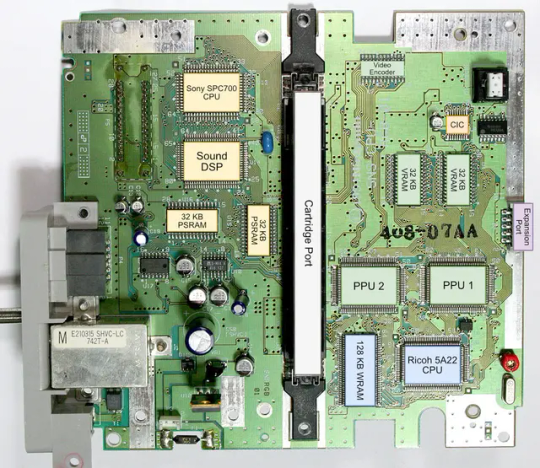
The SNES (or Super Famicom) does what it does by way of a combination of really going all in on direct memory access, and particularly having a dedicated setup for doing so between scanlines, coupled with a bunch of dedicated graphical modes specialized for different use cases, and you know, that you can switch between partway through drawing a screen. And of course the feature everyone knows and loves where you can have one polygon and do all sorts of fun things with it.
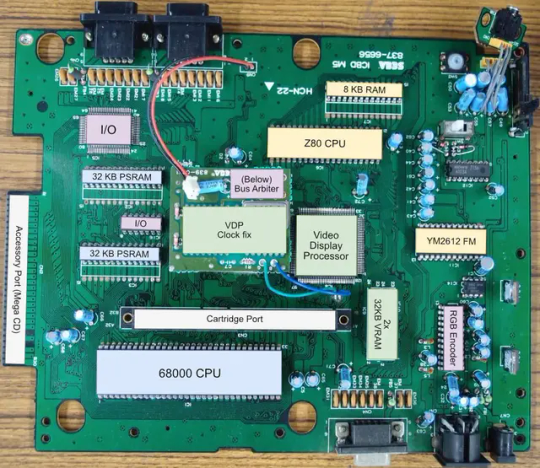
The Genesis (or Megadrive) has an actual proper 16-bit processor instead of this weird upgraded 6502 like the SNES had for a scrapped backwards compatibility plan. It also had this frankly wacky design where they just kinda took the guts out of a Sega Master System and had them off to the side as a segregated system whose only real job is managing the sound chip, one of those good good Yamaha synths with that real distinct sound... oh and they also actually did have a backwards compatibility deal that just kinda used the audio side to emulate an SMS, basically.
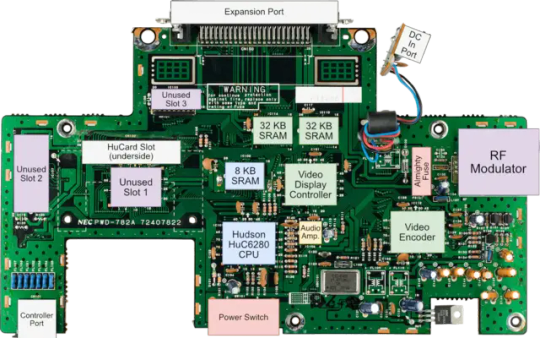
The TurboGrafix-16 (or PC Engine) really just kinda went all-in on making its own custom CPU from scratch which...we'll get to that, and otherwise uh... it had some interesting stuff going on sound wise? I feel like the main thing it had going was getting in on CDs early but I'm not messing with optical drives and they're no longer a really great storage option anyway.
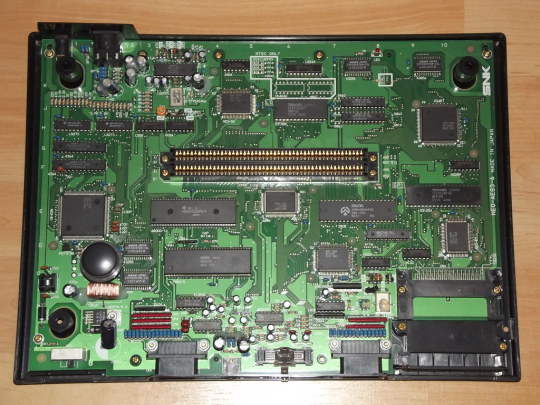
Then there's the Neo Geo... where what's going on under the good is just kind of A LOT. I don't have the same handy analysis ready to go on this one, but my understanding is it didn't really go in for a lot of nice streamlining tricks and just kinda powered through. Like it has no separation of background layers and sprites. It's just all sprites. Shove those raw numbers.
So what's the best of all worlds option here? I'd like to go with one of them nice speedy Motorolla processors. The 68000 the Genesis used is no longer manufactured though. The closest still-in-production equivalent would be the 68SEC000 family. Seems like they go for about $15 a pop, have a full 32-bit bus, low voltage, some support clock speeds like... three times what the Genesis did. It's overkill, but should remove any concerns I have about having a way higher resolution than the systems I'm jumping off from. I can also easily throw in some beefy RAM chips where I need.
I was also planning to just directly replicate the Genesis sound setup, weird as it is, but hit the slight hiccup that the Z80 was JUST discontinued, like a month or two ago. Pretty sure someone already has a clone of it, might use that.
Here's where everything comes to a screeching halt though. While the makers of all these systems were making contracts for custom processors to add a couple extra features in that I should be able to work around by just using newer descendant chips that have that built in, there really just is no off the shelf PPU that I'm aware of. EVERYONE back in the day had some custom ASIC (application-specific integrated circuit) chip made to assemble every frame of video before throwing it at the TV. Especially the SNES, with all its modes changing the logic there and the HDMA getting all up in those mode 7 effects. Which are again, something I definitely want to replicate here.
So one option here is... I design and order my own ASIC chips. I can probably just fit the entire system in one even? This however comes with two big problems. It's pricy. Real pricy. Don't think it's really practical if I'm not ordering in bulk and this is a project I assume has a really niche audience. Also, I mean, if I'm custom ordering a chip, I can't really rationalize having stuff I could cram in there for free sitting outside as separate costly chips, and hell, if it's all gonna be in one package I'm no longer making this an educational electronics kit/console, so I may as well just emulate the whole thing on like a raspberry pi for a tenth of the cost or something.
The other option is... I commit to even more work, and find a way to reverse engineer all the functionality I want out with some big array of custom ROMs and placeholder RAM and just kinda have my own multi-chip homebrew co-processors? Still PROBABLY cheaper than the ASIC solution and I guess not really making more research work for myself. It's just going to make for a bigger/more crowded motherboard or something.
Oh and I'm now looking at a 5V processor and making controllers compatible with a 10V system so I need to double check that all the components in those don't really care that much and maybe adjust things.
And then there's also FPGAs (field programmable gate arrays). Even more expensive than an ASIC, but the advantage is it's sort of a chip emulator and you can reflash it with something else. So if you're specifically in the MiSTer scene, I just host a file somewhere and you make the one you already have pretend to be this system. So... good news for those people but I still need to actually build something here.
So... yeah that's where all this stands right now. I admit I'm in way way over my head, but I should get somewhere eventually?
11 notes
·
View notes
Text
What are AI, AGI, and ASI? And the positive impact of AI
Understanding artificial intelligence (AI) involves more than just recognizing lines of code or scripts; it encompasses developing algorithms and models capable of learning from data and making predictions or decisions based on what they’ve learned. To truly grasp the distinctions between the different types of AI, we must look at their capabilities and potential impact on society.
To simplify, we can categorize these types of AI by assigning a power level from 1 to 3, with 1 being the least powerful and 3 being the most powerful. Let’s explore these categories:
1. Artificial Narrow Intelligence (ANI)
Also known as Narrow AI or Weak AI, ANI is the most common form of AI we encounter today. It is designed to perform a specific task or a narrow range of tasks. Examples include virtual assistants like Siri and Alexa, recommendation systems on Netflix, and image recognition software. ANI operates under a limited set of constraints and can’t perform tasks outside its specific domain. Despite its limitations, ANI has proven to be incredibly useful in automating repetitive tasks, providing insights through data analysis, and enhancing user experiences across various applications.
2. Artificial General Intelligence (AGI)
Referred to as Strong AI, AGI represents the next level of AI development. Unlike ANI, AGI can understand, learn, and apply knowledge across a wide range of tasks, similar to human intelligence. It can reason, plan, solve problems, think abstractly, and learn from experiences. While AGI remains a theoretical concept as of now, achieving it would mean creating machines capable of performing any intellectual task that a human can. This breakthrough could revolutionize numerous fields, including healthcare, education, and science, by providing more adaptive and comprehensive solutions.
3. Artificial Super Intelligence (ASI)
ASI surpasses human intelligence and capabilities in all aspects. It represents a level of intelligence far beyond our current understanding, where machines could outthink, outperform, and outmaneuver humans. ASI could lead to unprecedented advancements in technology and society. However, it also raises significant ethical and safety concerns. Ensuring ASI is developed and used responsibly is crucial to preventing unintended consequences that could arise from such a powerful form of intelligence.
The Positive Impact of AI
When regulated and guided by ethical principles, AI has the potential to benefit humanity significantly. Here are a few ways AI can help us become better:
• Healthcare: AI can assist in diagnosing diseases, personalizing treatment plans, and even predicting health issues before they become severe. This can lead to improved patient outcomes and more efficient healthcare systems.
• Education: Personalized learning experiences powered by AI can cater to individual student needs, helping them learn at their own pace and in ways that suit their unique styles.
• Environment: AI can play a crucial role in monitoring and managing environmental changes, optimizing energy use, and developing sustainable practices to combat climate change.
• Economy: AI can drive innovation, create new industries, and enhance productivity by automating mundane tasks and providing data-driven insights for better decision-making.
In conclusion, while AI, AGI, and ASI represent different levels of technological advancement, their potential to transform our world is immense. By understanding their distinctions and ensuring proper regulation, we can harness the power of AI to create a brighter future for all.
8 notes
·
View notes
Text
AI & Tech-Related Jobs Anyone Could Do
Here’s a list of 40 jobs or tasks related to AI and technology that almost anyone could potentially do, especially with basic training or the right resources:
Data Labeling/Annotation
AI Model Training Assistant
Chatbot Content Writer
AI Testing Assistant
Basic Data Entry for AI Models
AI Customer Service Representative
Social Media Content Curation (using AI tools)
Voice Assistant Testing
AI-Generated Content Editor
Image Captioning for AI Models
Transcription Services for AI Audio
Survey Creation for AI Training
Review and Reporting of AI Output
Content Moderator for AI Systems
Training Data Curator
Video and Image Data Tagging
Personal Assistant for AI Research Teams
AI Platform Support (user-facing)
Keyword Research for AI Algorithms
Marketing Campaign Optimization (AI tools)
AI Chatbot Script Tester
Simple Data Cleansing Tasks
Assisting with AI User Experience Research
Uploading Training Data to Cloud Platforms
Data Backup and Organization for AI Projects
Online Survey Administration for AI Data
Virtual Assistant (AI-powered tools)
Basic App Testing for AI Features
Content Creation for AI-based Tools
AI-Generated Design Testing (web design, logos)
Product Review and Feedback for AI Products
Organizing AI Training Sessions for Users
Data Privacy and Compliance Assistant
AI-Powered E-commerce Support (product recommendations)
AI Algorithm Performance Monitoring (basic tasks)
AI Project Documentation Assistant
Simple Customer Feedback Analysis (AI tools)
Video Subtitling for AI Translation Systems
AI-Enhanced SEO Optimization
Basic Tech Support for AI Tools
These roles or tasks could be done with minimal technical expertise, though many would benefit from basic training in AI tools or specific software used in these jobs. Some tasks might also involve working with AI platforms that automate parts of the process, making it easier for non-experts to participate.
3 notes
·
View notes